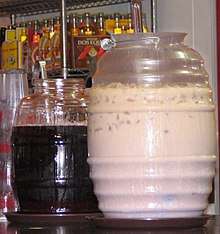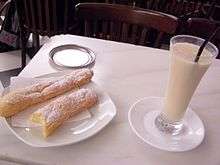Horchata
Horchata (/ɔːrˈtʃɑːtə/; Spanish: [oɾˈtʃata] (![]()
History and composition
Horchata, which comes from the Latin term hordeata, which in turn comes from hordeum (barley), is a term related to a Mediterranean tradition of grain-based beverages and also the linguistic root of orgeat syrup. The Valencian or Chufa horchata is made with dried and sweetened tiger nuts (Cyperus esculentus).[1] This form of horchata is now properly called horchata de chufa[1][2] or, in West African countries such as Nigeria and Mali, kunnu aya.[3][4][5] By 1000 CE it had spread to Hispania (now Spain) with the Muslim conquest.[1] There are 13th-century records of a horchata-like beverage made near Valencia.[6]
From Valencia, where it remained popular, the concept of horchata was brought to the New World. Here, drinks called agua de horchata or simply horchata came to be made with white rice and cinnamon or canella instead of tiger nuts.[1] Sometimes these drinks had vanilla added,[2] or were served adorned with fruit.[1]
Today, these and other similarly-flavoured plant milk beverages are sold in various parts of the world as varieties of horchata or kunnu.
Varieties
Horchata de chufa or kunnu aya

The drink now known as horchata de chufa (also sometimes called horchata de chufas[7] or, in West African countries such as Nigeria and Mali, kunnu aya[3][4][5]) is the original form of horchata.[1] It is made from soaked, ground and sweetened tiger nuts.[1] According to researchers at the University of Ilorin, kunnu made from tiger nuts is an inexpensive source of protein.
It remains popular in Spain, where a regulating council exists to ensure the quality and traceability of the product in relation to the designation of origin.[8] There it is served ice-cold as a natural refreshment in the summer, often served with fartons. Horchata de chufa is also used instead of dairy milk by the lactose-intolerant.
The majority of the Spanish tiger nut crop is utilised in the production of horchata de chufa.[9] Alboraya is the most important production centre.[9]
In rare instances, various forms of aflatoxin may be present in horchata de chufa.[10]
Horchata de arroz

Horchata de arroz is made of rice, sometimes with vanilla and typically with canela[1] or cinnamon.[1][11][12]
It is the most common variety of horchata in Mexico and Guatemala. In the United States, it is popular in taquerías and Mexican ice cream shops.[13][14][15]
In Alvarado, horchata de arroz is scented with flowers of the Aztec marigold (cempasúchil or Tagetes erecta).[16]
Though horchata de arroz was once typically homemade, it is now available in both ready-to-drink (shelf-stable or refrigerated) and powdered form in grocery stores, principally in the U.S. and Latin America.
Horchata de arroz is one of the three typical drink flavours of Mexican aguas frescas, together with tamarindo and hibiscus.
Horchata de ajonjolí
Horchata de ajonjolí ("sesame horchata") is made with ground sesame seeds. In Puerto Rico, it is typically made by boiling sugar, vanilla, and cinnamon sticks in water, and then pouring the infusion over ground sesame seeds to be left overnight. The mixture is then strained through a cheesecloth. Some recipes call for added ground rice, ground almonds, evaporated milk, coconut milk, allspice and rum, or barley and lime zest.
Horchata is also made with sesame seeds, water and sugar in Zulia, an area in the west of Venezuela.
Semilla de jicaro
In the Central American countries of El Salvador, Nicaragua, Honduras, and Costa Rica, horchata refers to the drink known as semilla de jicaro, made from jicaro seeds ground with rice and spices such as ground cocoa, cinnamon, sesame seeds, nutmeg, tiger nuts and vanilla. Ground peanuts, almonds and cashews may be added. Because of these ingredients, horchata is usually strained before serving.
Horchata as a flavour

Horchata as a flavour makes appearances in ice cream, cookies and other sweets, and other products such as RumChata, an alcoholic tribute to the beverage. Some smoothie shops, cafés, and McDonald's in the U.S. have been experimenting with horchata-flavoured frappes.[22]
Etymology
The name derives from Valencian orxata, probably from ordiata, made from ordi ("barley": Latin *hordeata < hordeum).[21] The Italian orzata, the French and English orgeat have the same origin, though the beverages themselves have diverged, and are generally no longer made from barley.[23]
A charming false etymology recounts that James I of Aragon, after being given the drink for the first time by a local in Alboraya, exclaimed in Valencian, "Açò és or, xata!" ("That's gold, pretty girl!").[24][25][26]
See also
- Kunnu aya
- Salep
- Orgeat syrup
- Chicha
- Plant milk
References
- Goldstein, Darra (4 July 2018). "The Oxford Companion to Sugar and Sweets". Oxford University Press – via Google Books.
- Cho, Susan; Almeida, Nelson (29 May 2012). "Dietary Fiber and Health". CRC Press – via Google Books.
- Cho, Susan; Almeida, Nelson (29 May 2012). "Dietary Fiber and Health". CRC Press – via Google Books.
- Cheney, Dina (3 May 2016). "The New Milks: 100-Plus Dairy-Free Recipes for Making and Cooking with Soy, Nut, Seed, Grain, and Coconut Milks". Simon and Schuster – via Google Books.
- Gittleman, Ann Louise (19 May 2017). "The New Fat Flush Foods". McGraw Hill Professional – via Google Books.
- Clifford A. Wright, Mediterranean Vegetables, 2012, ISBN 1558325913, s.v. 'chufa'
- Grigson, Jane (1 January 1983). Jane Grigson's book of European cookery. Atheneum – via Internet Archive.
horchata (chufa OR tiger).
- "Consejo Regulador de la D.O. Chufa de Valencia. Horchata de Chufa de Valencia - Portada". Chufadevalencia.org. 2002-12-31. Retrieved 2014-07-15.
- Leitch, James Muil (4 July 1967). "Food Science and Technology: Manufacture and distribution of foods". Gordon and Breach – via Google Books.
- Weidenbörner, Martin (24 January 2014). "Mycotoxins in Foodstuffs". Springer Science & Business Media – via Google Books.
- "Horchata de Arroz Tostado (Toasted Rice Drink)". Saveur.
- "Horchata de Arroz con Almendras (Almond-Rice Drink)". Saveur.
- Emeril Lagasse, Horchata Recipe : Food Network Taste of Mexico, 2007.
- Horchata Recipe & Video - Martha Stewart.
- Refreshing Rice Drink: Horchata de Arroz by Karen Hursh Graber 2003 (MexConnect).
- Gonzalez, Anita (4 July 2018). "Jarocho's Soul: Cultural Identity and Afro-Mexican Dance". University Press of America – via Google Books.
- "RECIPE: Horchata". Los Dos. Archived from the original on 2017-07-31. Retrieved 2016-08-02.
- "Horchata de Melón (Cantaloupe Seed Drink)". Saveur.
- Adriana Janovich. "Heavenly Horchata" - The Spokesman-Review APRIL 29, 2015
- "Horchata de semillas de melón". allrecipes.com.mx.
- Rios, Montserrat; Tinitana, Fani; Jarrín, Pablo; Donoso, Natalia; Romero-Benavides, Juan Carlos (9 March 2017). ""Horchata" drink in Southern Ecuador: medicinal plants and people's wellbeing". Journal of Ethnobiology and Ethnomedicine. 13. article №18. doi:10.1186/s13002-017-0145-z.
- "McDonald's Testing Horchata Frappes in Southern California". Foodbeast. May 12, 2014. Retrieved July 15, 2017.
- Lobscouse & Spotted Dog: Which It's a Gastronomic Companion to the Aubrey/Maturin Novels : Grossman, Anne Chotzinoff; Thomas, Lisa Grossman ISBN 0-393-04559-5
- Valencia & the Costa Blanca, Miles Roddis, Lonely Planet, 2002, ISBN 1-74059-032-5 Google Books
- MTV Spain, Fernando Gayesky, Elizabeth Gorman, Kristin Luna, Andre Legaspi, Frommer's, 2007, ISBN 0-7645-8772-2 Google Books
- Consejo regulador denominación de origen Chufa de Valencia,"Història de l'roxata de xufa".
External links
- The Regulating Council of Denomination of Origin "Chufa de Valencia": Quality council regulating tiger nut horchata in Valencia
- Article about Horxata, Ltd.: Valencian Horchata in New York City

.svg.png)


.jpg)
